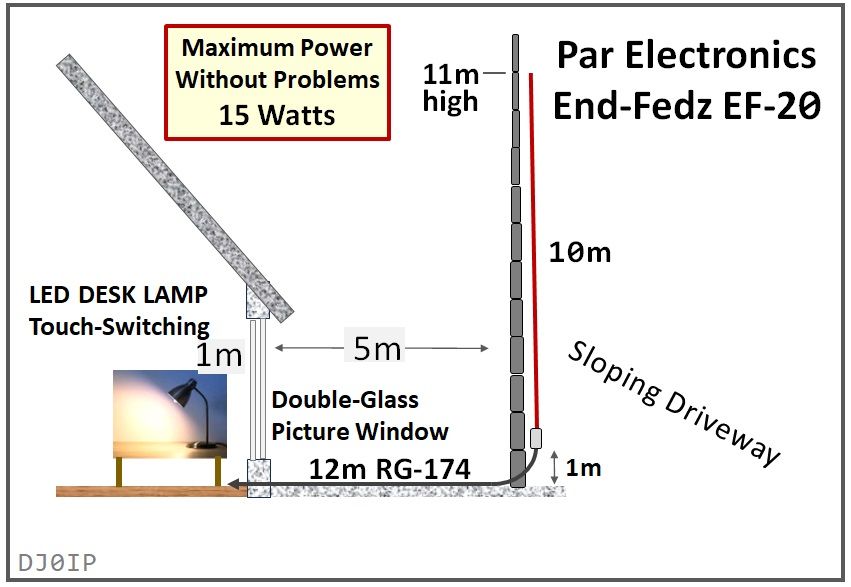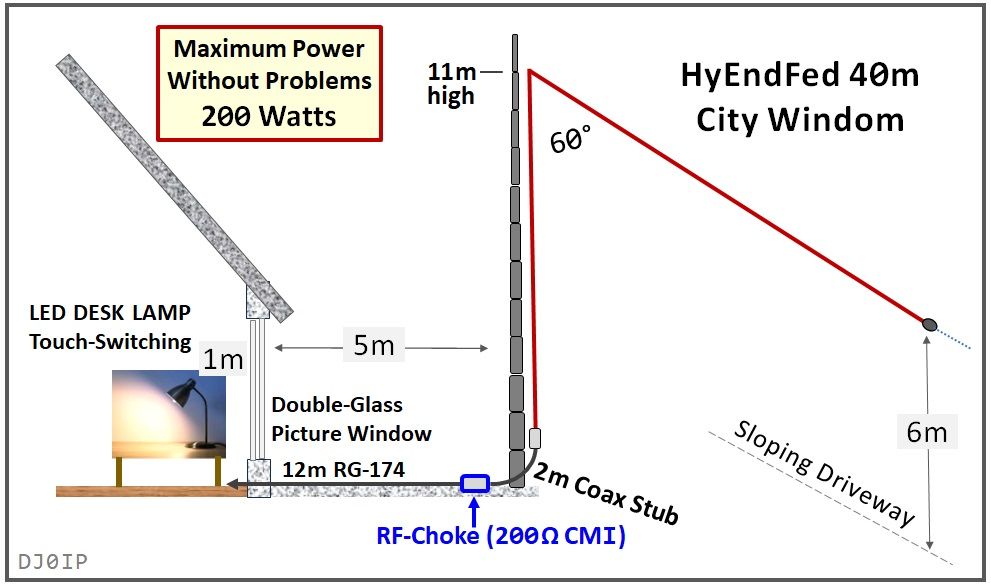The END-FED HALF-WAVE ANTENNA
V.s.
THE END-CONNECTED OFF-CENTER-FED DIPOLE
Common Mode Current on the Coax
and RFI in the House.
Although the EFHW is a popular well-know antenna, the ECOCFD is unknown to most hams. The ECOCFD is also called a "City Windom" by one commercial vendor. Both antennas share the feature of having the coax exit one end of the antenna, making them ideal for apartment dwellers - all they need is a window and a tree!
Any time we erect the antenna close to the house, we increase the risk of having RFI in the house. RFI can be caused by two things: 1) Direct Radiation, and 2) Common Mode Current.
If the cause is Direct Radiation, there is not much we can do except move the antenna farther away from the house, or reduce the transmitted power.
I recently erected my ECOCFD and two commercial EFHW antennas (one at a time), just 5 meters (17 ft.) away from a large picture window in the wall of the house, with the radio desk just behind the window. In other words, there was only about 6 meters (20 ft.) between the antenna and the station.
The
LED lamp sitting on the operating desk is plastic with capacitive "touch" switches for ON/OFF and dimming. It was the first device to experience RFI.
THE RFI TEST:
I erected the pole on the edge of the patio, within about 20 ft. of the station. I first transmitted 80 Watts of CW for a quick view of what was happening. Both EFHW antennas killed the function of the lamp, but the ECOCFD did not.
Next, I reduced power as low as possible and then slowly increased power to determine at what power level the RFI problem began.
The
EF-20 is a 20m Monoband EFHW. The family of EF- antennas was designed and sold by Par-Electronics, then sold to LNR Precision, and sold again to Vibroplex, the current manufacturer of these antennas.
The RFI problems began and were intermittent at just
15 Watts. At 20 Watts, the lamp switched on and its controls would no longer work. In order to fix the problem and restore operation, I had to power-cycle the lamp.
The antenna is an efficient radiator but I cannot use it "as is" near the house.

This HyEndFed is a commercial 40m EFHW that works on the 40/20/10m bands. It has low SWR on these bands, but exhibits the same RFI issues as the EF-20 above.
Power in excess of 15 Watts caused RFI issues in the shack.
Using this antenna "as is" so close to the house creates problems.
The RFI issues will be addressed below.

The feedpoint of the ECOCFD antenna is not the point where the coax feedline attaches to the antenna. It is at the 4:1 Ruthroff UNUN (shown at a height of about 5m in the drawing).
The 1:1 Guanella (choke-balun) where the coax attaches to the antenna prevents Common Mode Current from flowing on the feedline.
I can run at least 500 Watts with this antenna without any RFI issues.

(NOTE: My transistorized linear amplifier only puts out 500 Watts, so I was not able to determine how much power I can actually run with this antenna without issues.)
ELIMINATING THE RFI ISSUES WITH THE EFHW ANTENNAS:

The RFI issues were eliminated by inserting a common mode current RF choke and a short stub of coax between the antenna's feedpoint and the coax feedline.
NOTE: The choke has 2000 Ohms not 200.
(I will update the drawing soon.)

The RFI issues were eliminated by inserting a common mode current RF choke and a short stub of coax between the antenna's feedpoint and the coax feedline.
NOTE: The choke has 2000 Ohms not 200.
(I will update the drawing soon.)
Contrary to what you may often read elsewhere, an EFHW antenna requires a counterpoise, though it may be very short. According to Steve Yates, AA5TB, the counterpoise need only be 0.05 wavelength long. See: The End Fed Half Wavelength Antenna.
In the examples above, I have substituted a short stub of coax for the counterpoise, then inserted an RF choke with 2k Ohms between it and the coax feedline. This cured my problem with RFI in the shack. I was able to run 200 Watts into both EFHW antennas without any interference. The antennas are not rated for more power so I stopped at 200 Watts.
I increased the length of the coax stub on the EF-20 to 2 meters in length. It still worked just fine. I assume I can use this length on a multiband antenna like the HyEndFed and it will still be good on higher bands.
I had planned to run more tests with different chokes, different lengths of coax, etc., but unfortunately I had to take down the fiberglass pole. I was only permitted to have it up for a couple of days.
